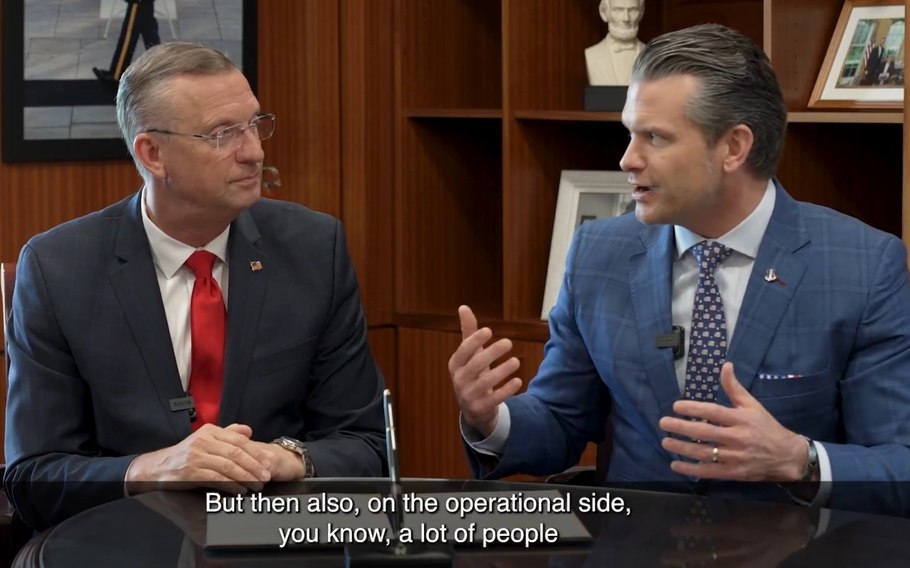
A screen grab of a video posted to X by Secretary of Veterans Affairs Doug Collins, in which Collins (left) and Defense Secretary Pete Hegseth discuss a new collaboration between their departments to improve veterans’ health care. (Secretary of Veterans Affairs via X)
Late last month in Washington, a handshake heralded what could have been a new era for our service members transitioning to the civilian workforce. Secretary of Veterans Affairs Doug Collins and Defense Secretary Pete Hegseth announced a new collaboration to improve and unify the delivery of health care to veterans. In a video released May 28, Collins and Hegseth vowed to work more closely to better serve veterans after service, but missed one critical part of this issue.
“We train them, we equip them, we prepare them, we turn them into warfighters,” Hegseth said during their meeting. “ But then, when they move into the civilian world ... transition has to happen properly, carefully, thoughtfully, so that we follow through on the promise of what they deserve.”
My fellow advocates pushing for reforms to federal military employment transition programs agree. Yet, the new Memorandum of Understanding between DOD and VA fails to mention support for veterans to connect with family-sustaining civilian jobs. If Collins and Hegseth are committed to “supporting those who sacrifice for our nation,” as the MOU states, that means recognizing that effective employment transition is vital to veterans’ well-being.
This short-sighted MOU is a missed opportunity: An overhaul of federal military transition programs is overdue to help the 200,000-plus service members who leave the military each year succeed. Despite their unique skills, more than half of veterans struggle to find civilian jobs. Not only can it be difficult to leverage their military experience to post-service roles, federal programs designed to help them find employment are fragmented and don’t effectively track outcomes, creating stress and uncertainty.
The U.S. government spends more than $13 billion annually to help reintegrate service members into civilian life through programs like the DOD’s mandatory Transition Assistance Program. Most funding goes to educational programs like the GI Bill, which covers the costs for post-secondary schools or training, rather than programs focused squarely on employment.
TAP is just one of 45 federal programs overseen by 11 federal agencies that help veterans transition, according to the U.S. Government Accountability Office and Rand Corp. This patchwork of programs makes it difficult for veterans to connect with the right ones. And there is little data on how well individual programs work. Just two have been independently evaluated; 27 of 45 federal programs have released no performance data.
We applaud Collins and Hegseth for prioritizing veteran health care. We urge them to extend this strengthened partnership to improve federal military transition programs. Backed by policy advocacy and research, we recommend the following for a successful partnership:
Think big. Don’t proliferate new federal services. Rather, analyze and restructure existing programs to enact a holistic, systemwide transformation.
Track and measure outcomes. Institute uniform standards focused on impact. Ongoing, long-term tracking of veteran outcomes is lacking; most efforts focus on short-term output measures rather than overall outcomes and longitudinal studies on career, financial and personal stability.
Track and measure outcomes. Institute uniform standards focused on impact. Ongoing, long-term tracking of veteran outcomes is lacking; most efforts focus on short-term output measures rather than overall outcomes and longitudinal studies on career, financial and personal stability.
One size does not fit all. Transition experiences vary widely, yet many programs are one-size-fits-all. Expanding individualized support and improving program accountability are key to enhancing transition outcomes.
Strengthen partnerships. Invest in proven nonprofit partners such as VetJobs, Hire Heroes USA, and the D’Aniello Institute for Veterans & Military Families’ Onward to Opportunity that fill critical gaps in transition services — often more efficiently than federal programs. Organizations like The Heinz Endowments have long supported programs like this to improve veteran employment outcomes and build brighter futures for veterans.
Veterans nationwide are facing massive employment upheaval amid federal job reductions; they comprise nearly 25% of the federal workforce. The need for effective employment support for veterans is greater than ever. In fact, VA researchers have referred to the first year after service as “the deadly gap” for transitioning veterans due to an elevated risk for death by suicide; establishing meaningful employment can help. Robust support for veterans can combat negative public perceptions of military service. And a thriving veteran population is the surest way to sustain an all-volunteer force and keep our nation secure.
The transition of service members from the military to civilian jobs is not a moment in time — it is a lifelong process that shapes the future of veterans and their families. Successful transition requires tailored support, informed policy, and large-scale, cross-sector cooperation — exemplified by collaboration between VA and DOD. We stand with Collins and Hegseth in the unwavering belief that “from the first time a recruit dons the uniform, they begin a lifelong journey connected to both” DOD and VA. They must keep that promise by helping our veterans connect with jobs that fully utilize their extensive experience. Veterans have too much talent and training to waste.
Megan Andros is director of Veterans Affairs at The Heinz Endowments, a Hoover Veteran Fellow, a graduate of the United States Military Academy at West Point and a former ordnance officer and combat veteran who served in Operation Iraqi Freedom with the Army’s 1st Cavalry Division.